Finding real world object in camera's view.
This is the most simplistic answer possible, as there are many unknowns that will affect the result.
The problem
The image illustrates the problem as I understand it. 
We have 3 ships (the minimum required to find a solution) marked with a red A,B,C. We know the latitude and longitude of each ship. As they are close there is no need to correct for any distortion due to converging longitudes.
The green lines represent the camera's view, the image is projected via a lens onto the CCD (green line above A) The twp gray lines then are projected onto the camera's screen below the ship.
Triangulation and triangles.
From the longitudes we can find the distance from each ship to the other, giving us the lengths of the sides of a triangle.
var ships = {
A : { lat : ?, long : ? },
B : { lat : ?, long : ? },
C : { lat : ?, long : ? },
}
var AB = Math.hypot(ships.A.lat - ships.B.lat, ships.A.long - ships.B.long);
var BC = Math.hypot(ships.C.lat - ships.B.lat, ships.C.long - ships.B.long);
var CA = Math.hypot(ships.A.lat - ships.C.lat, ships.A.long - ships.C.long);
The inset triangle shows how to find the angle of a corner given the lengths of the sides.
For this we are after the angle pheta
var pheta = Math.acos(BC * BC - AB * AB + CA * CA) / (-2 * AB * CA));
The camera's field of view.
Now we need an extra bit of information. That is the field of view of the camera (in image as the green lines and red FOV). You will have to find those details for the camera you are using.
A typical phone camera has a focal length (fl) from 24-35mm equivalent and knowing the CCD size in relative terms you can find the FOV with var FOV = 2 * Math.atan((CCD.width / 2) / fl) But this is problematic as a modern phone is under 10mm thick and the CCD is tiny, what are the actual dimensions?
There is a long and complicated process you can use to determine the FOV without knowing the internal dimensions of the camera, but easy to look up the phone specs.
For now let's assume the camera has a FOV of 67deg (1.17radians). If the camera has a resolution of 1280 and we ignore lens distortions, and keep the camera vertical and at the same level as the targets , we can calculate the distance in pixels between the two ships via the angle between them.
var FOV = 1.17; // radians the Field of View of the camera
var pixels = (1.17 / 1280) * pheta; // 1280 is horizontal resolution of display
So now we have the distance in pixels between the two ships on the camera. Assuming that they fit on the camera we are missing one more important bit of information.
Bearings
We need to know which way the camera is pointing as a bearing. Only when we have that can we find the ships. So lets assume the GPS on the phone gives you the live bearing. What we need is the bearing to one of the ships.
I had to dig deep into my archives to find this, It had no source or referance so can only provide as is. All it had is Haversin so assuming that is the method used.
After some further digging I found a referance to what is likely the original source code that this was derived from Calculate distance, bearing and more between Latitude/Longitude points
function deg2rad(angle) { return angle * 0.017453292519943295 }
function rad2deg(angle) { return angle / 0.017453292519943295 }
//return bearing in radians.
function getBearing(lat1,lon1,lat2,lon2){
var earth = 6371e3;
var lat1 = lat1.toRadians();
var lat2 = lat2.toRadians();
var lon1 = lon1.toRadians();
var lon2 = lon2.toRadians();
var latD = lat2-lat1;
var lonD = lon2-lon1;
var a = Math.sin(latD / 2) * Math.sin(latD / 2) + Math.cos(lat1 ) * Math.cos(lat2) * Math.sin(lonD / 2) * Math.sin(lonD / 2);
var c = 2 * Math.atan2( Math.sqrt(a), Math.sqrt(1-a) );
return earth * c;
}
So now you can get the bearing from you to one of the ships. Use that and your bearing to find the difference in angle between you and it.
var yourBearing = ?; // in radians
var shipBBearing = getBearing(ships.A.lat, ships.A.long, ships.B.lat, ships.B.long);
Now get the differance in angle
var shipBAt = yourBearing - shipBBearing
Knowing the pixel FOV
var shipBPixelsFromCenter = (FOV / 1280) * shipBAt;
var shipBXpos = 1280 / 2 - shipBPixelsFromCenter;
// and from above the dif in pixels between ships is
var shipCXpos = shipBXpos + pixels.
And done.

